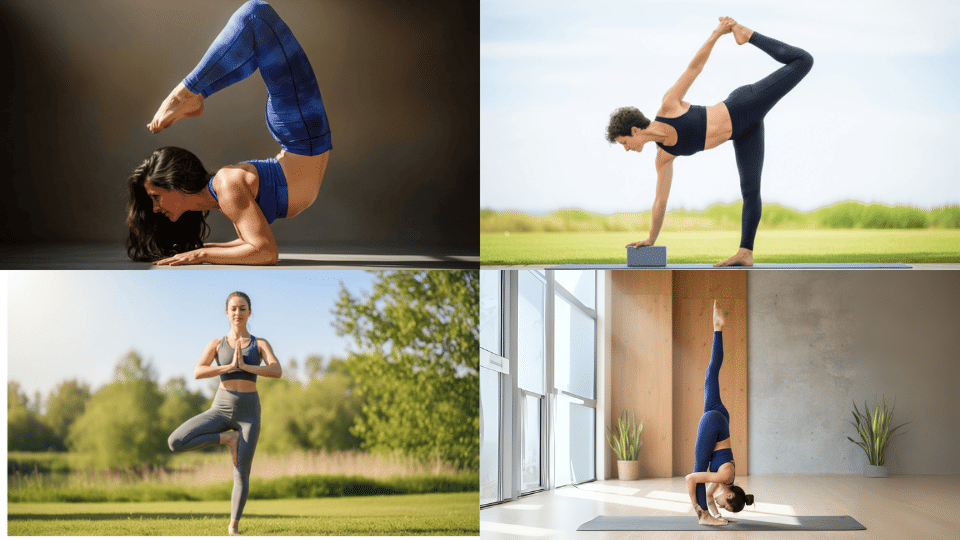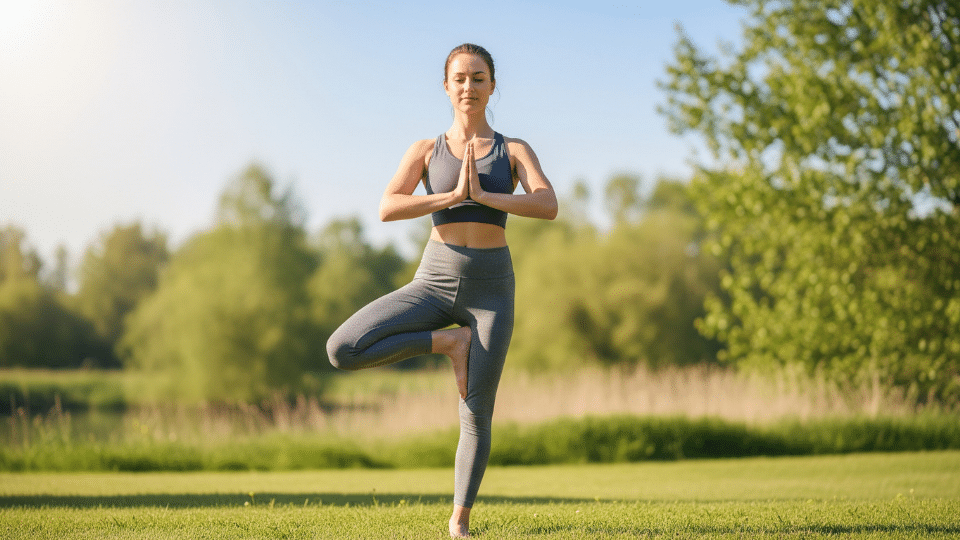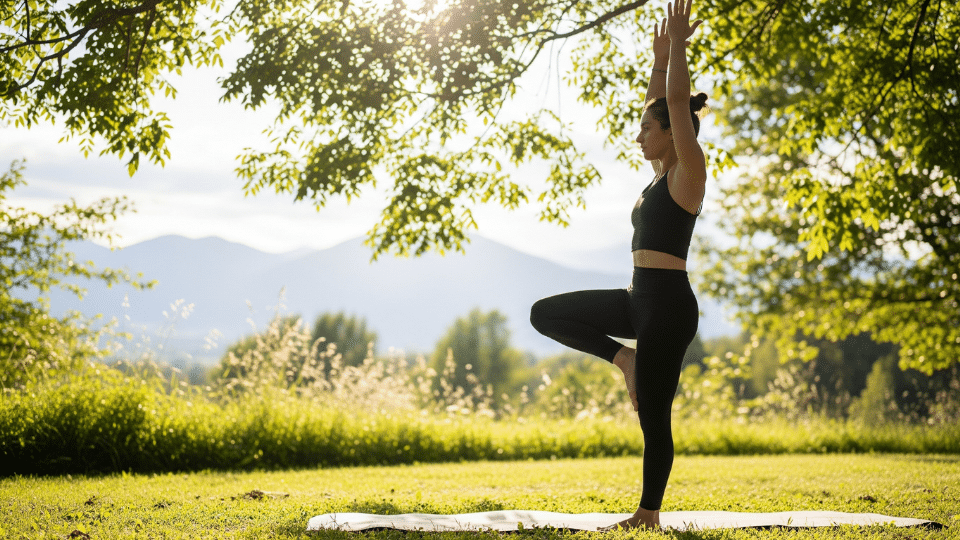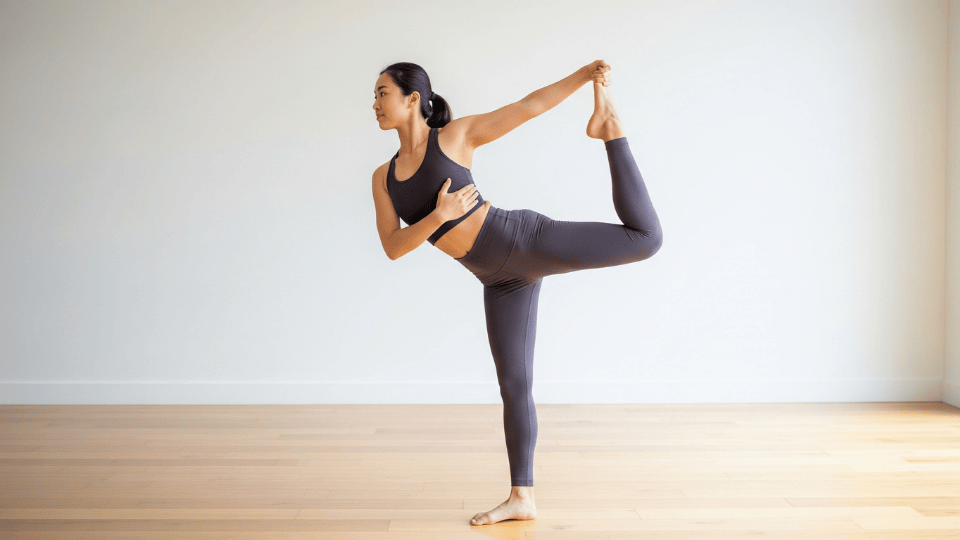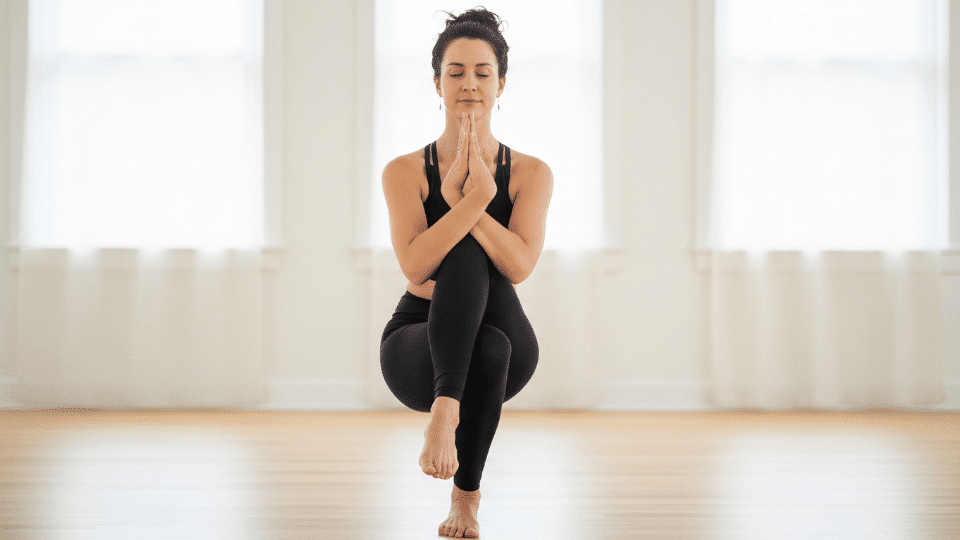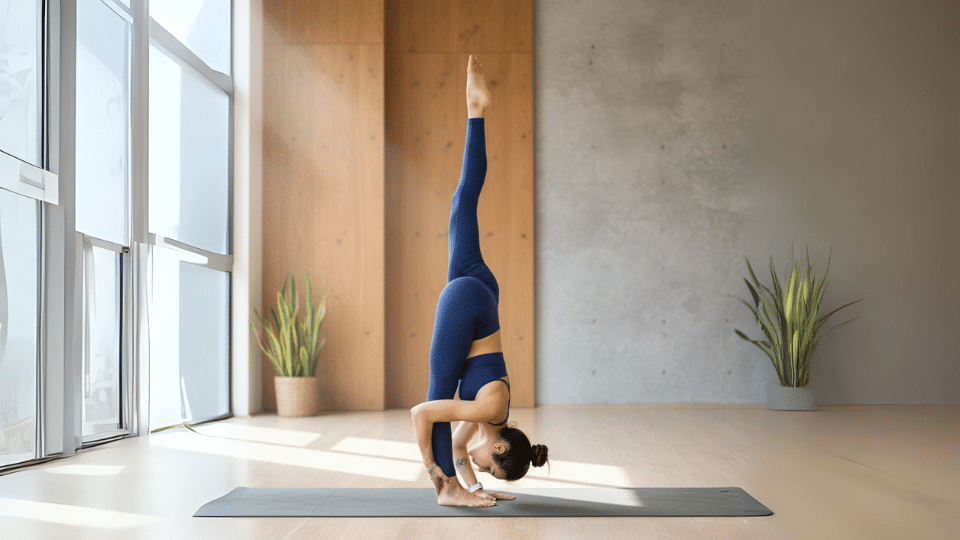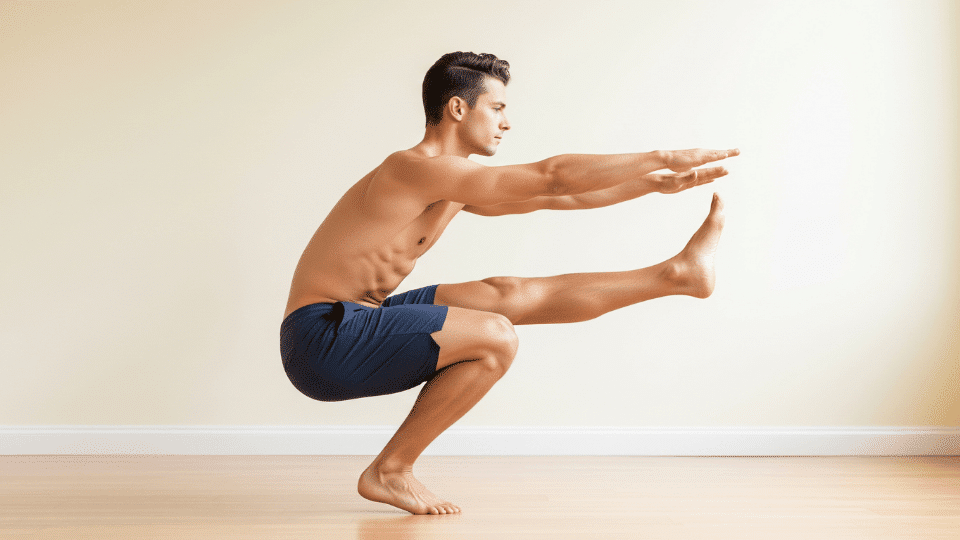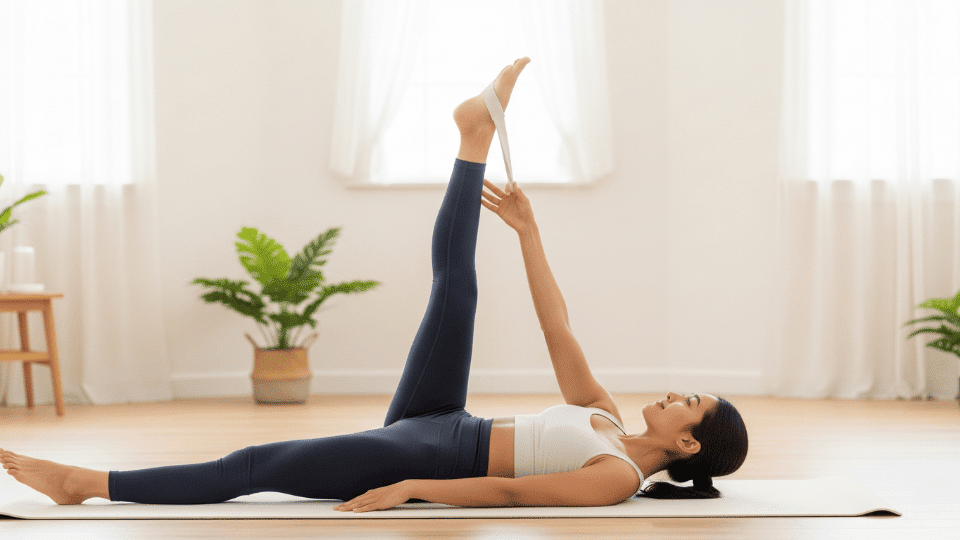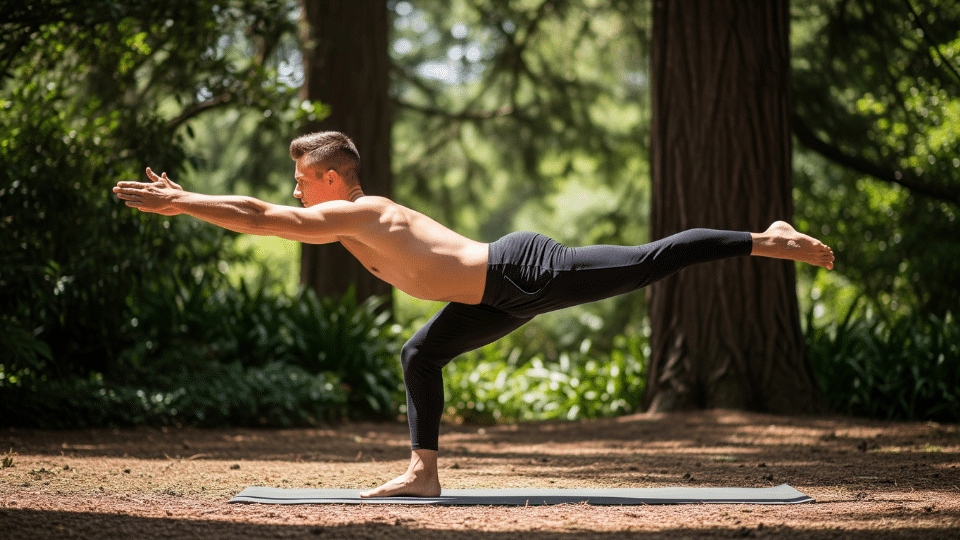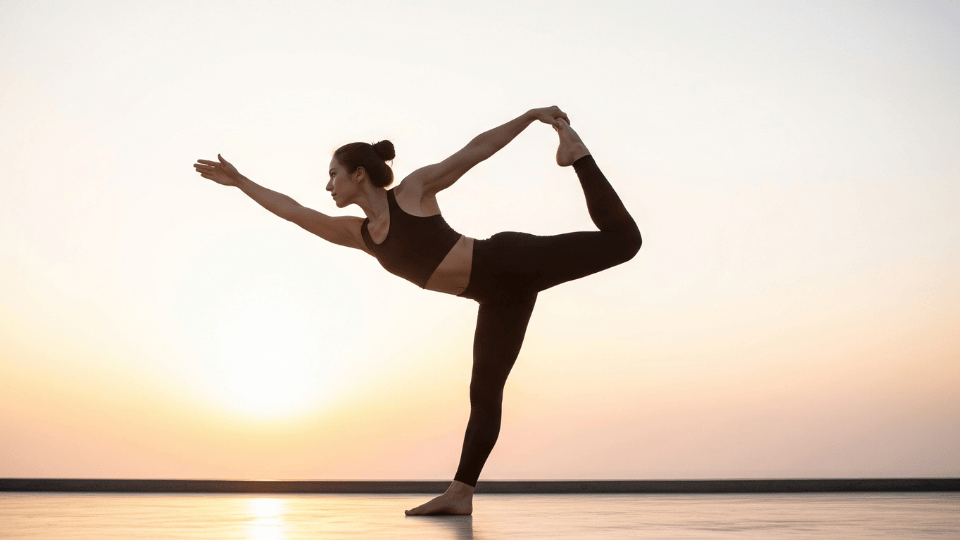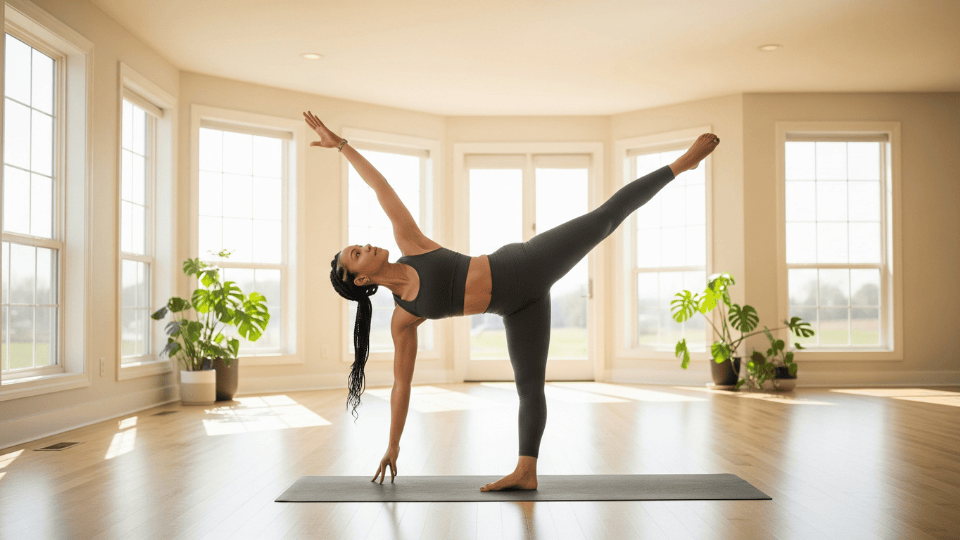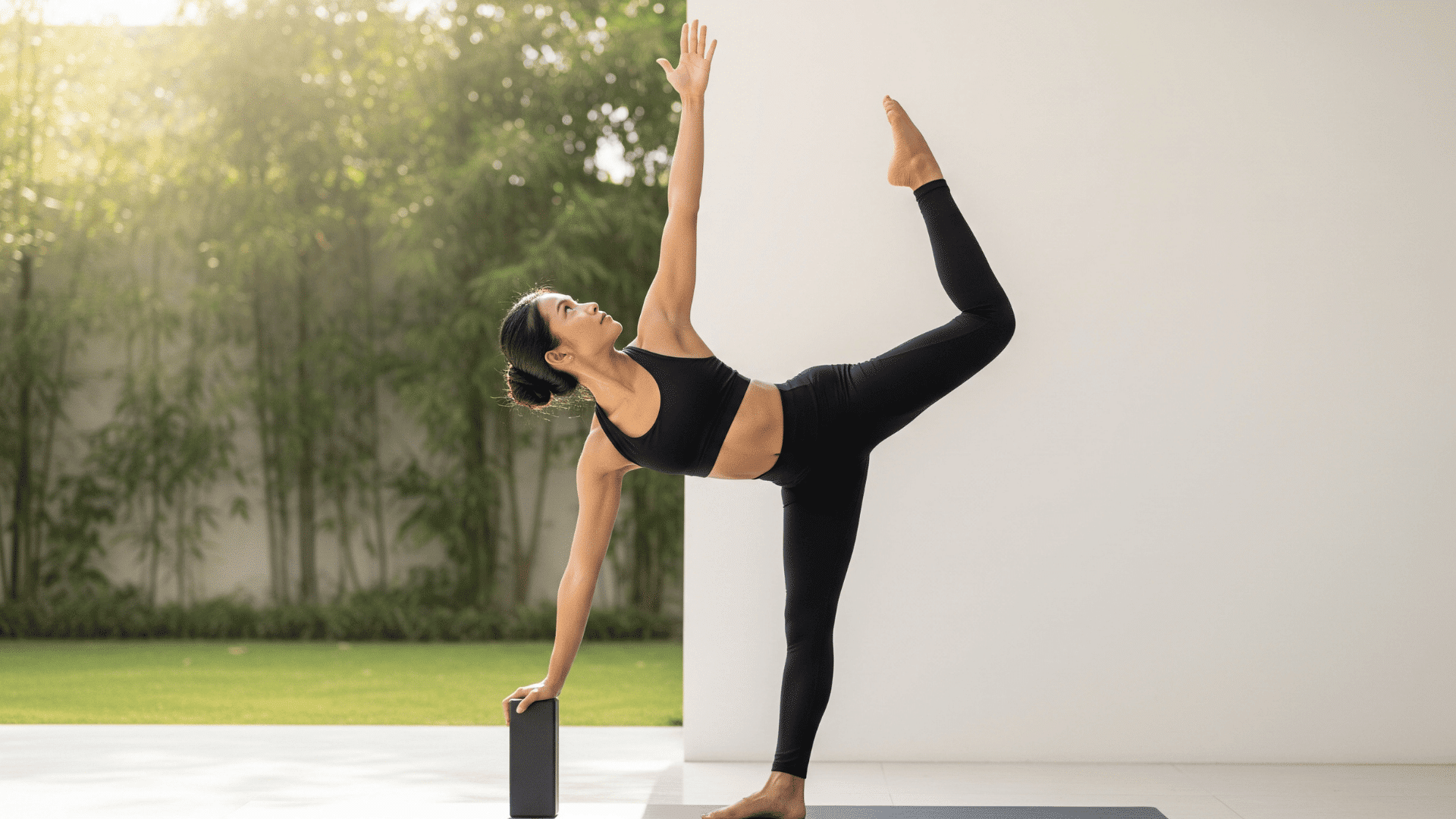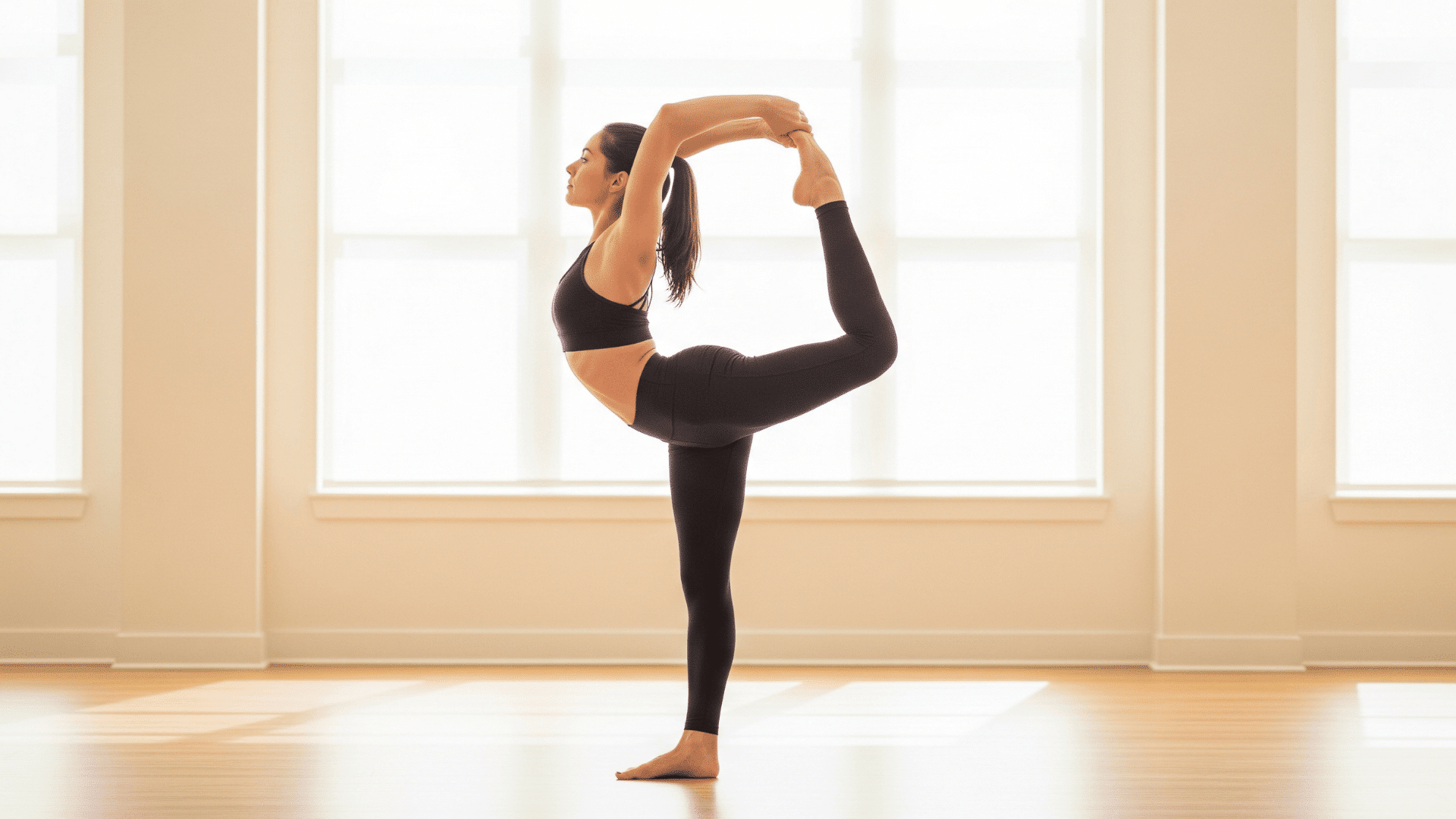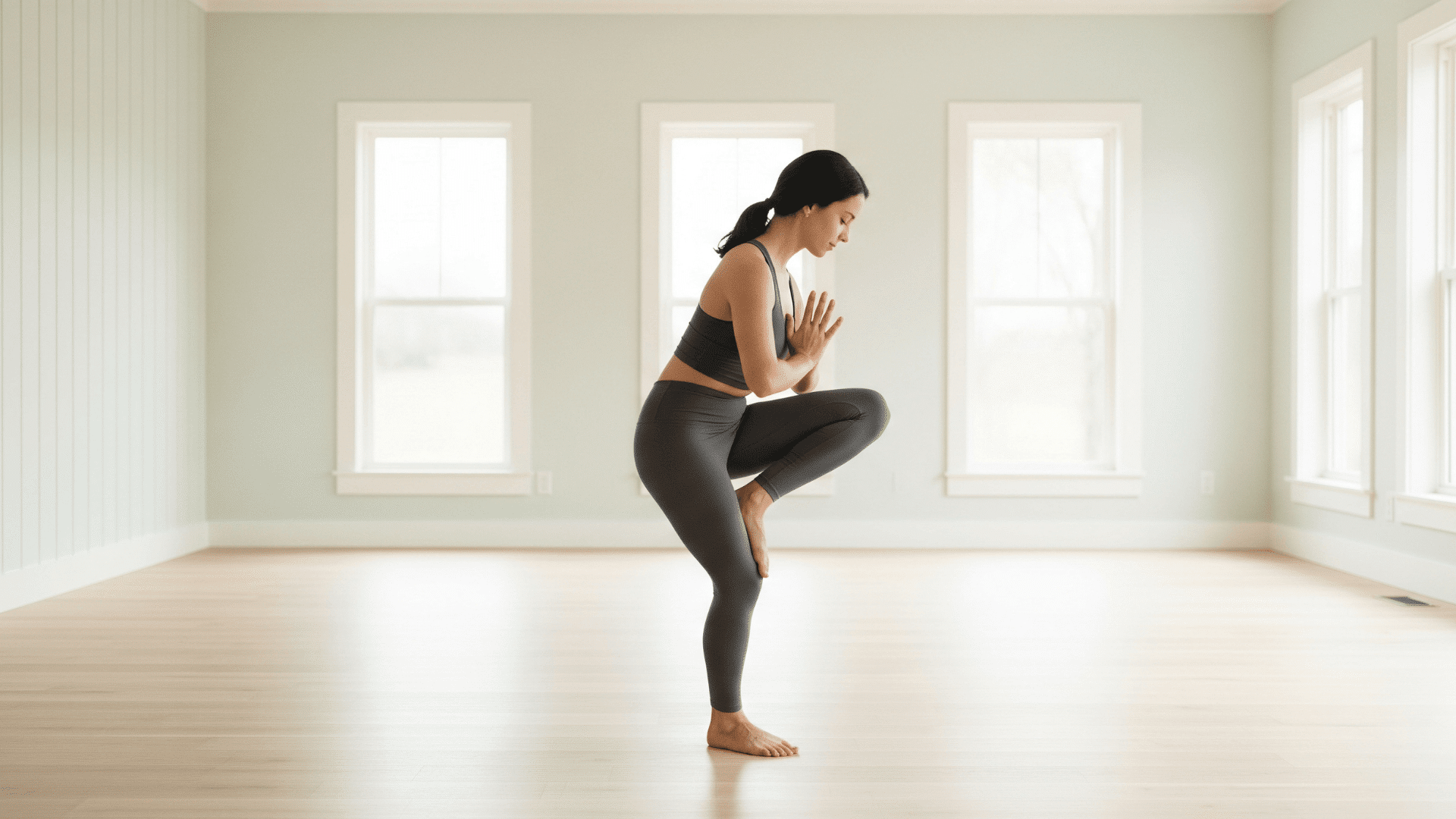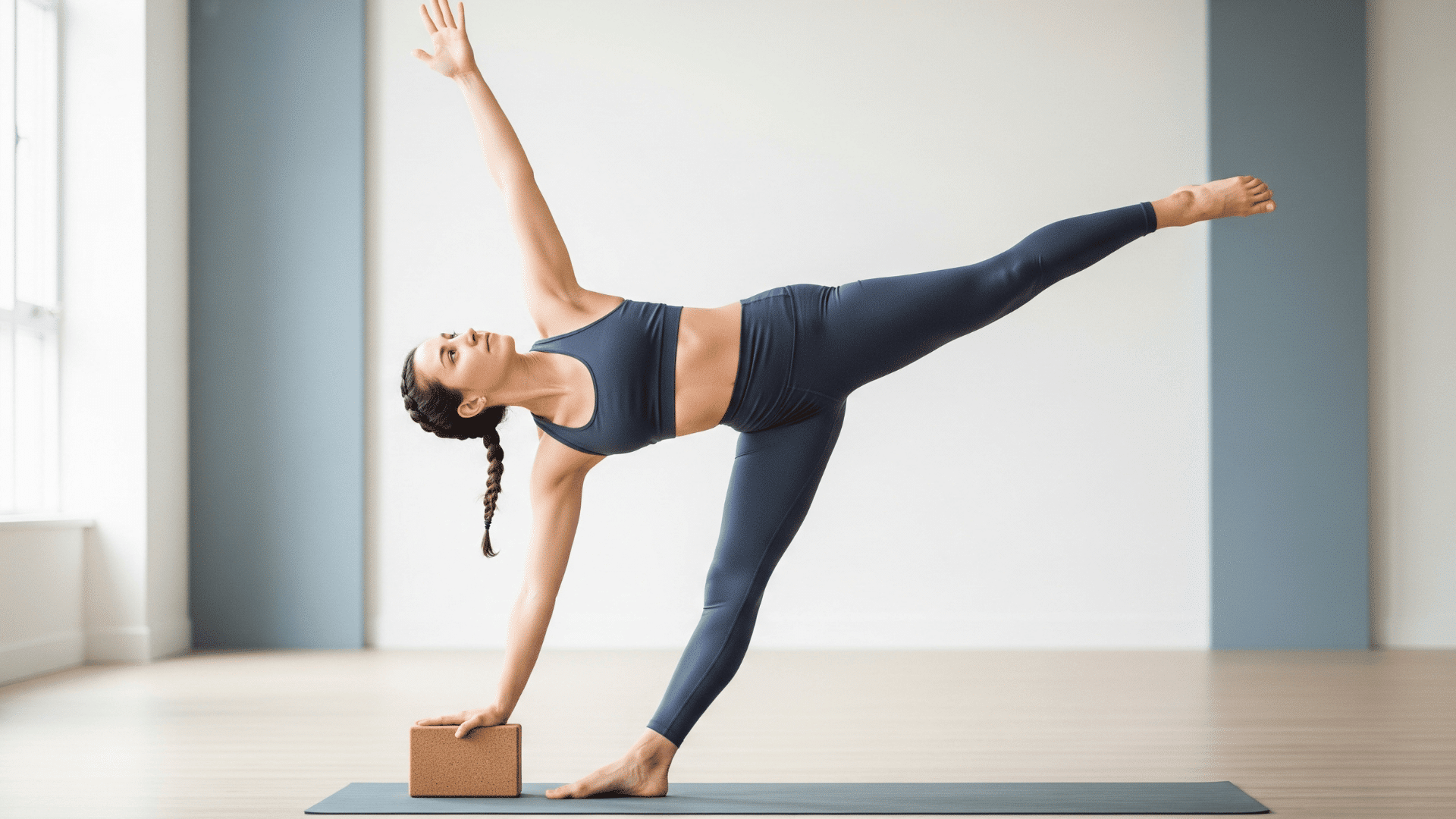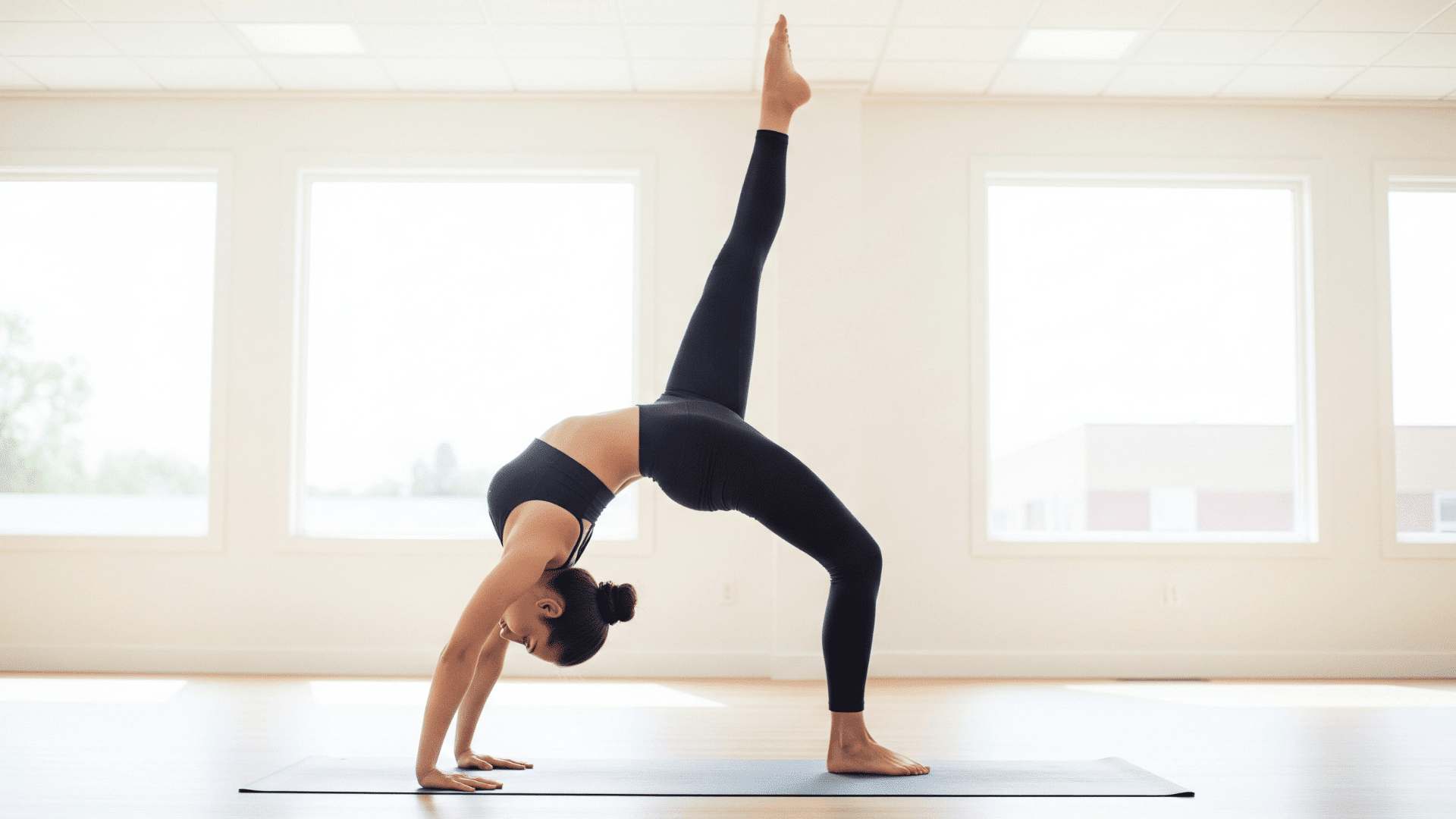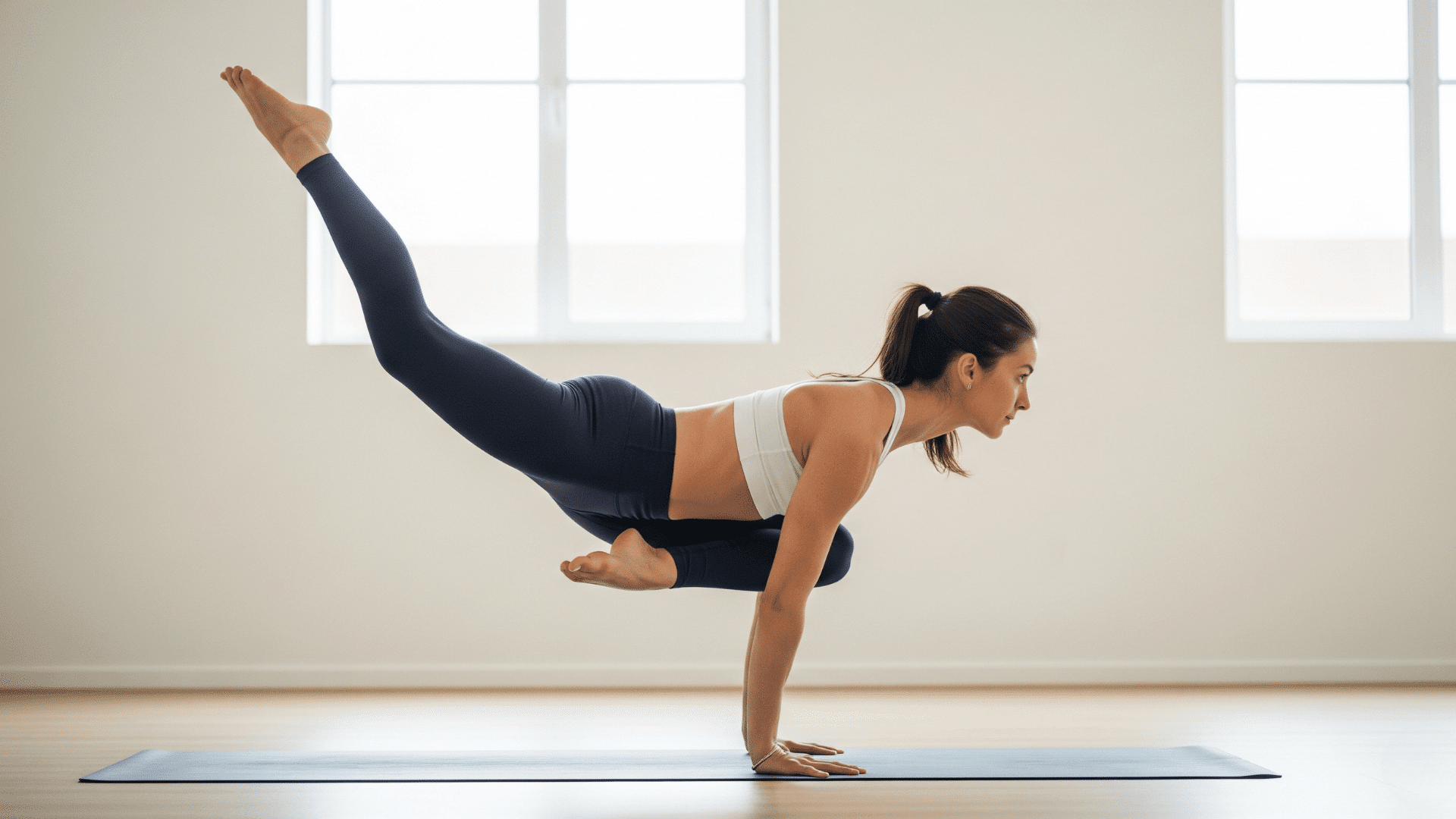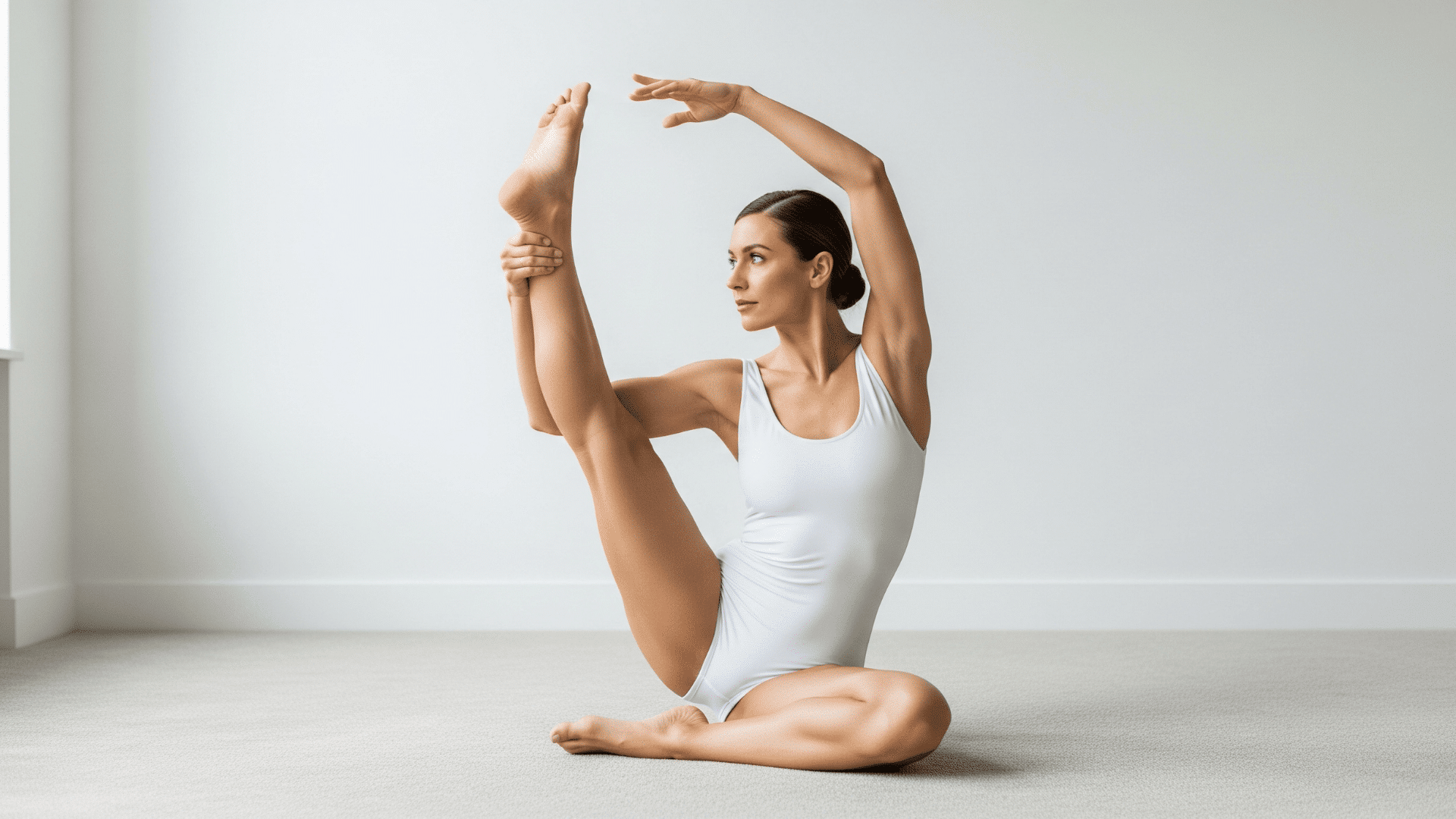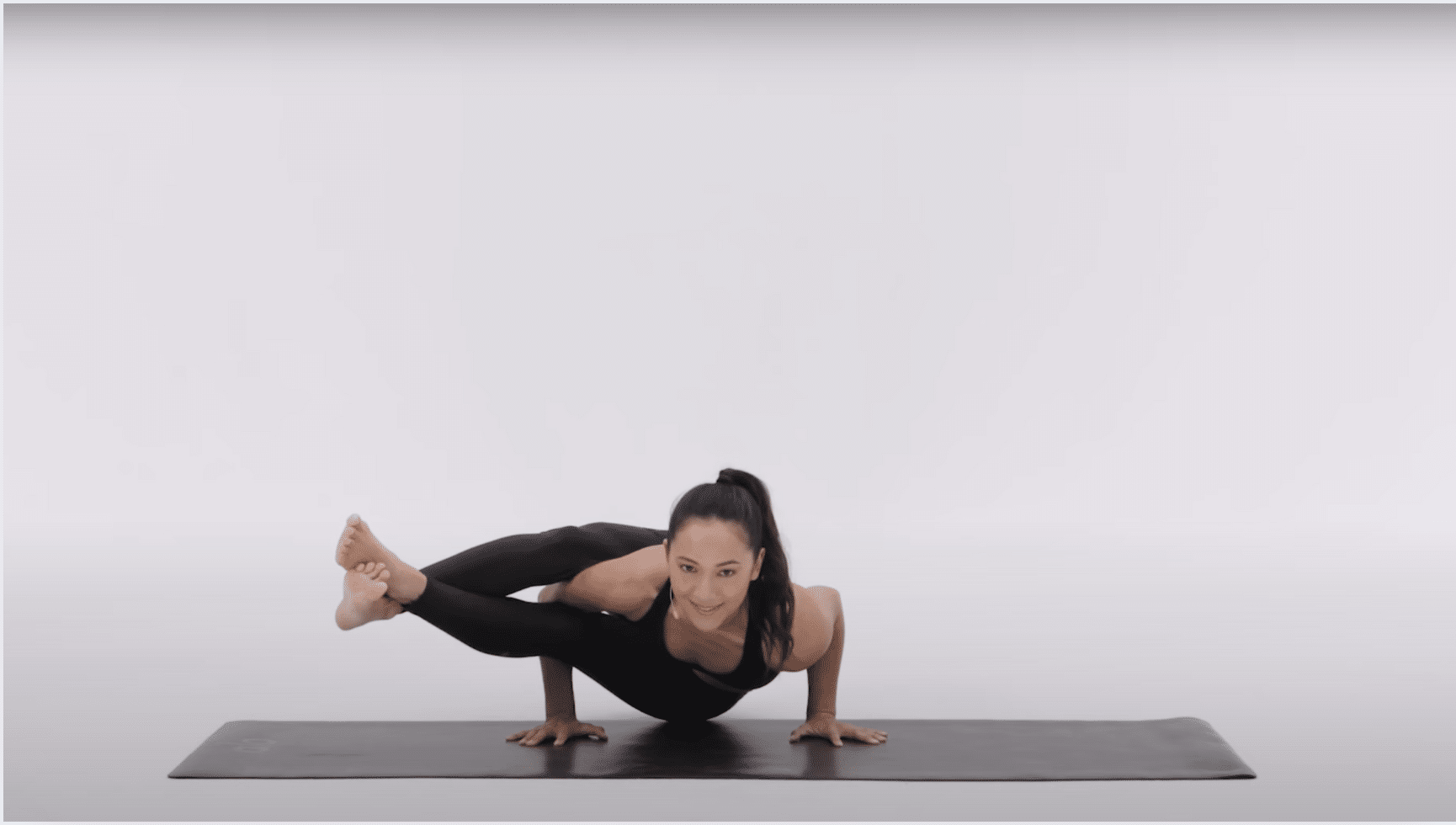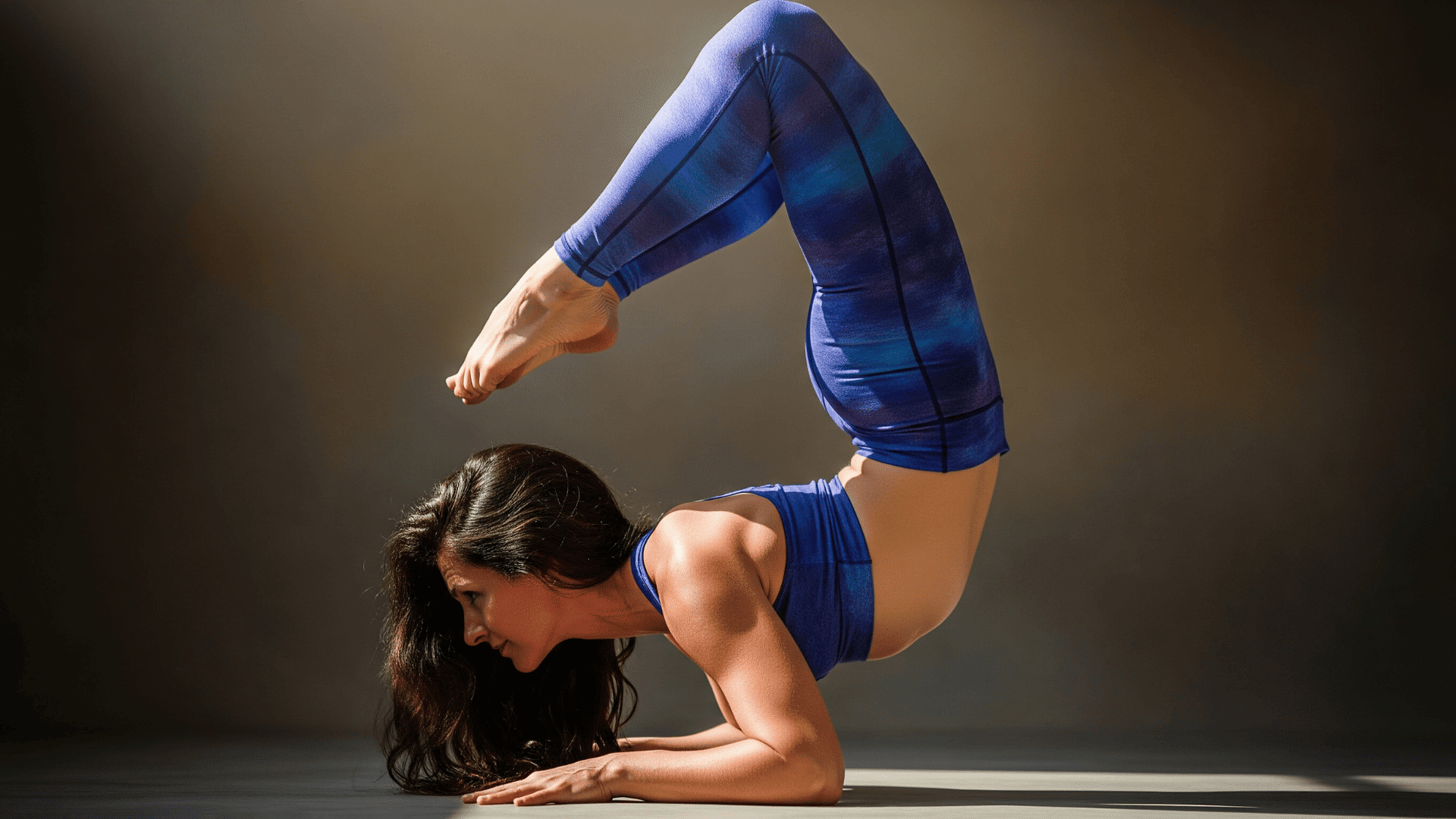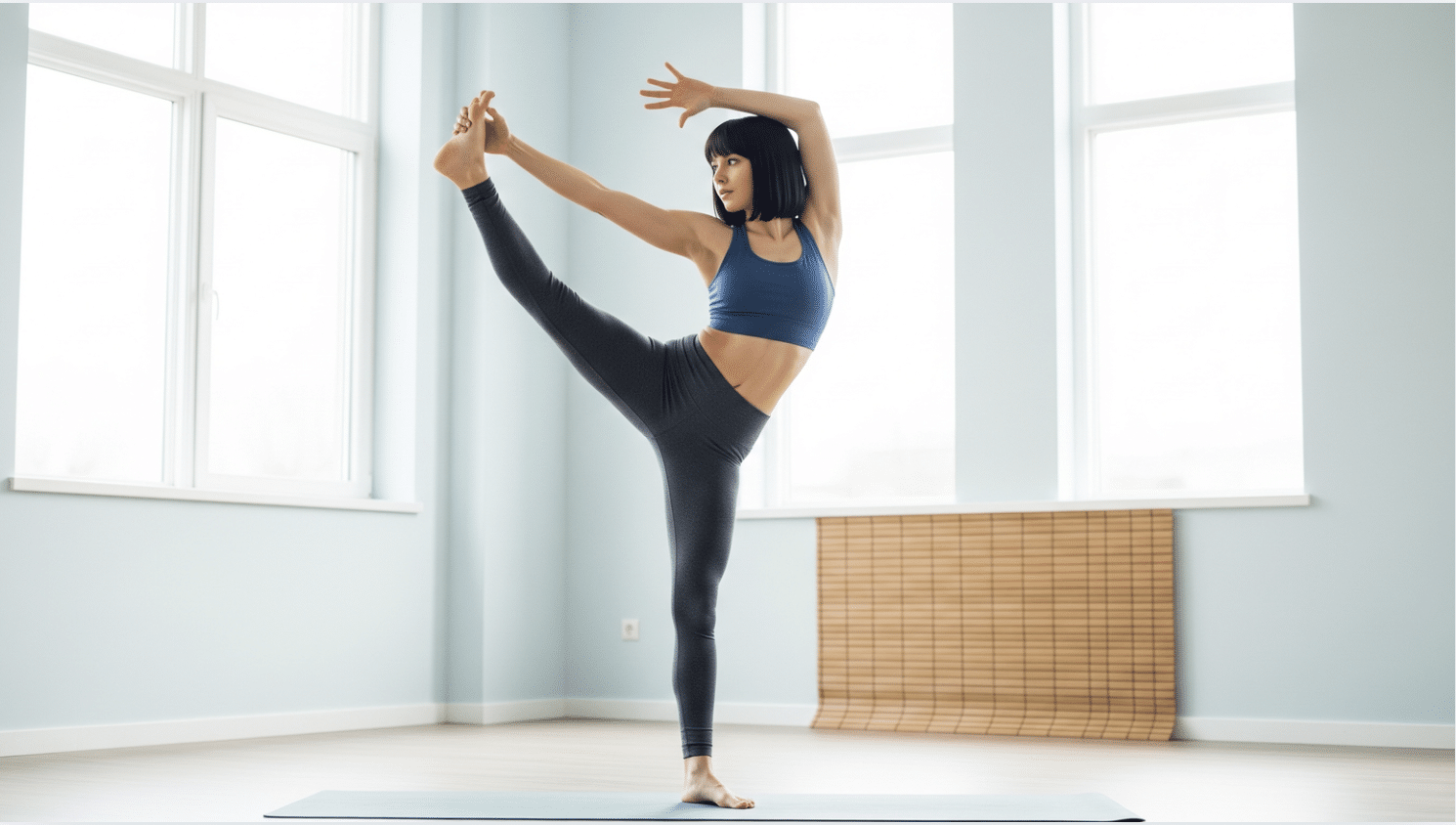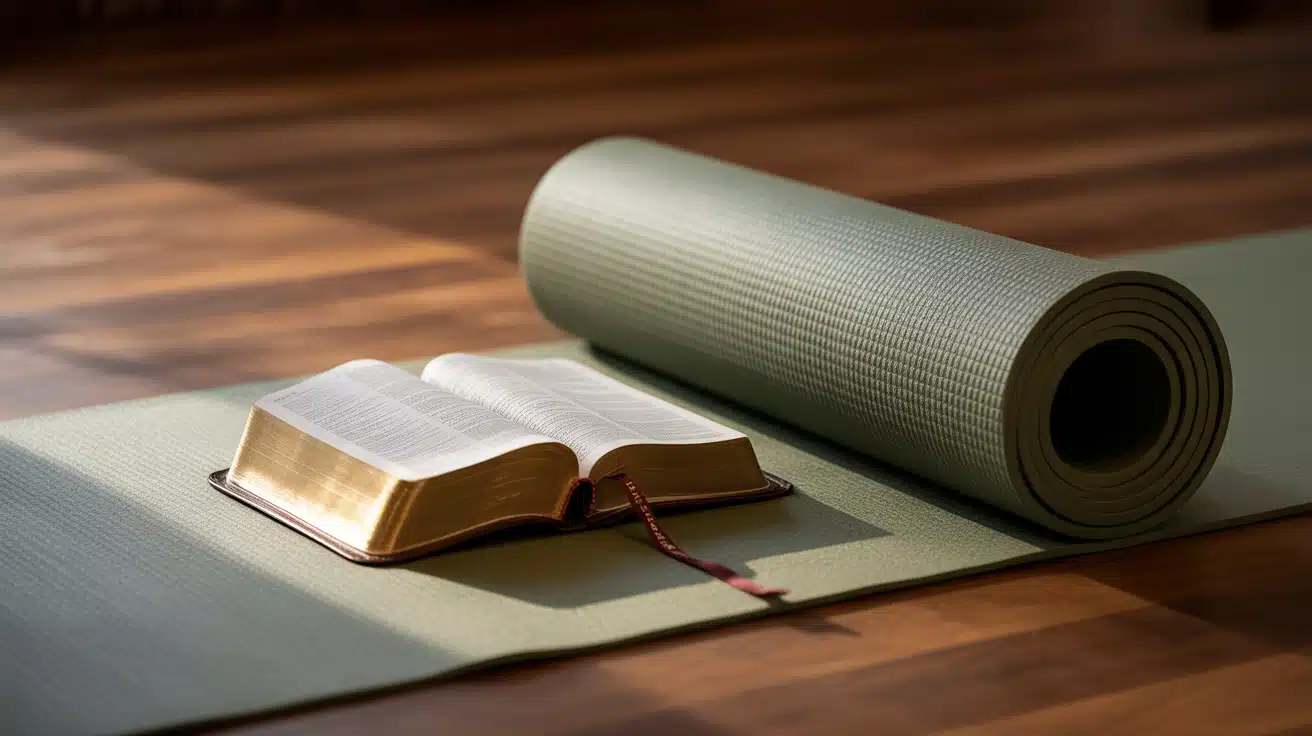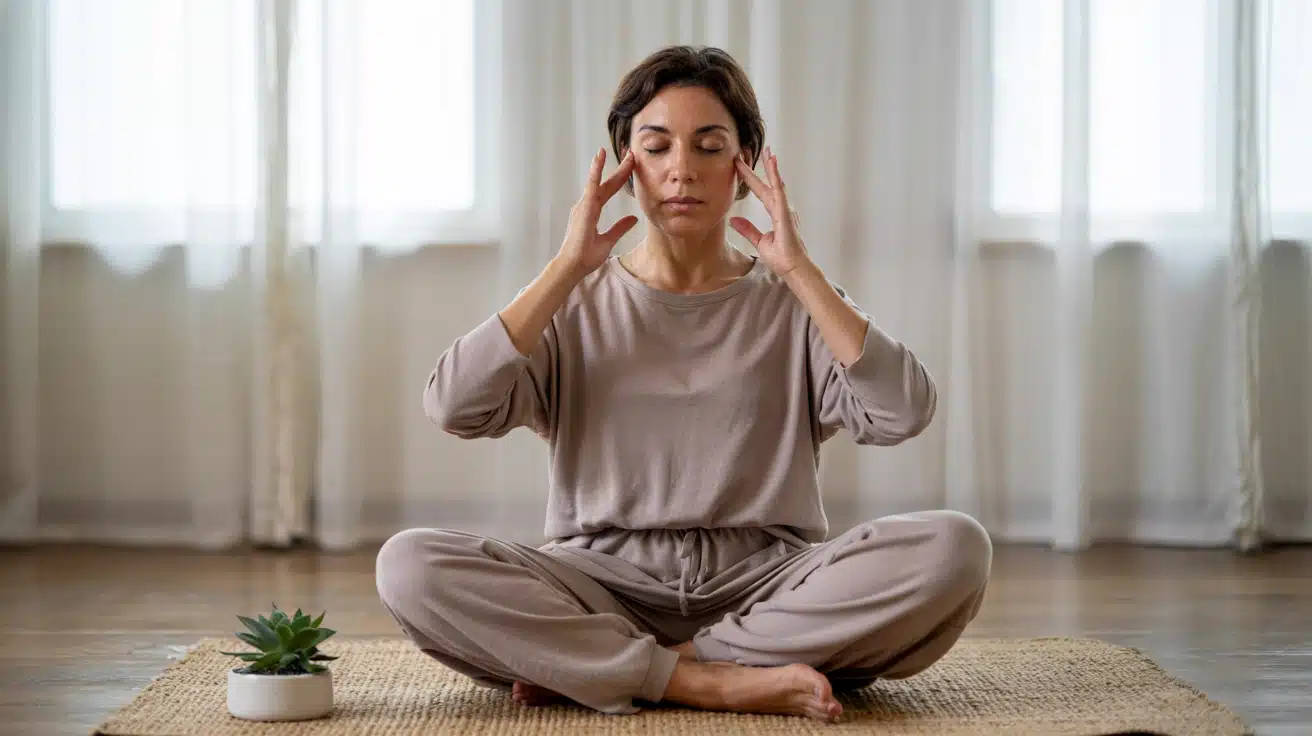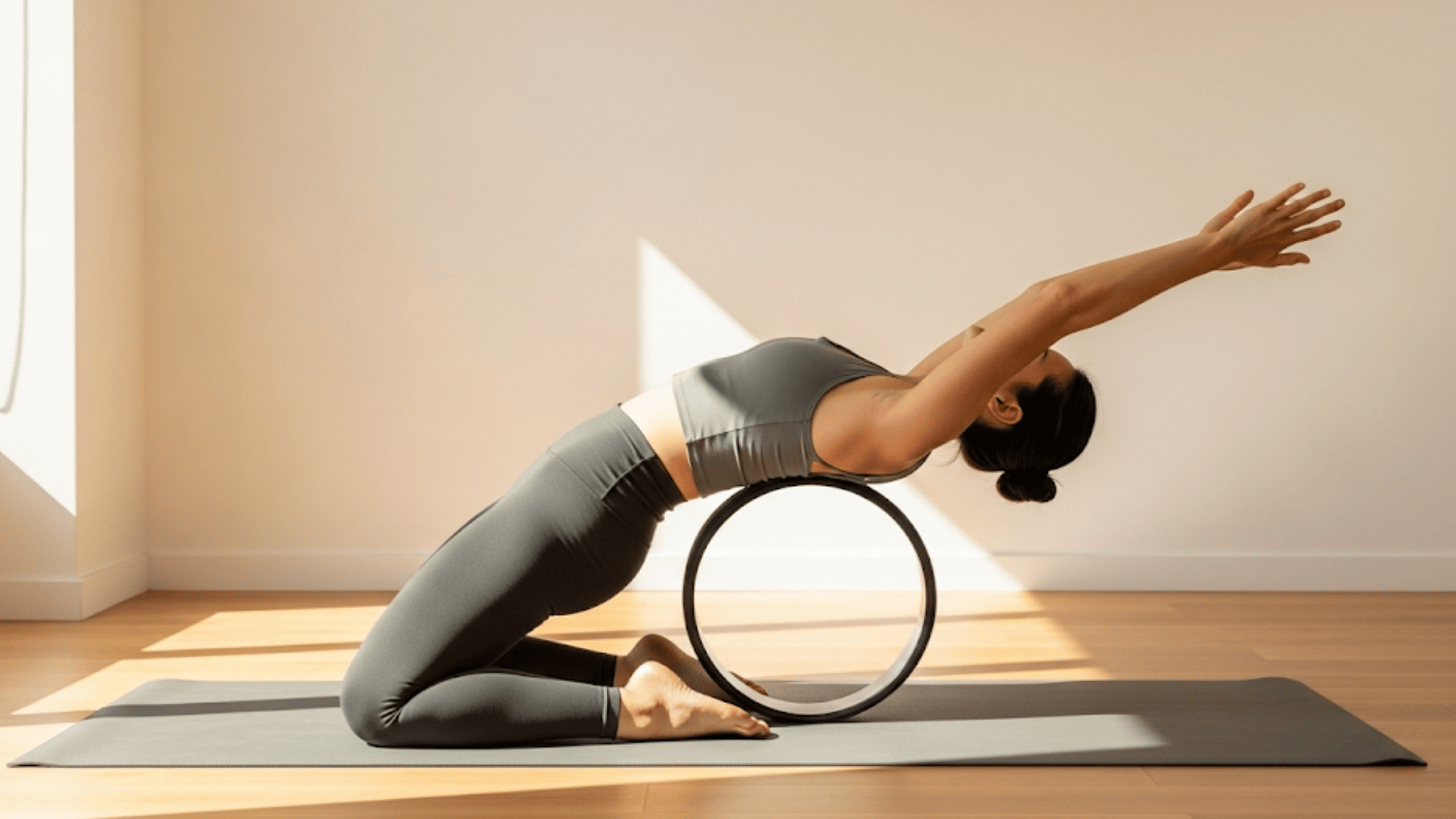Ever tried standing on one leg and suddenly felt like a baby deer on ice?
It turns out that’s not just clumsiness. It’s your body waking up muscles and reflexes that rarely get called into action.
Balancing on one leg isn’t just for show-offs or circus acts. It’s serious body training that whispers strength and focus into every tiny movement.
From wobbly ankles to racing thoughts, everything gets a workout.
But here’s the good news: You don’t need to be a yoga master to start. Even the simplest balance practice can make you steadier, stronger, and more aware of how your body moves.
Ready to wobble your way to better balance, stronger muscles, and sharper focus? Let’s lift one foot and find your center!
Single-Leg Yoga Fundamentals
Single-leg yoga poses shake up your body’s usual habit of using both legs for support. This forces you to wake up those deep, stabilizing muscles that usually stay quiet during everyday activities.
These poses work by throwing off your center of gravity, which means your ankles, core, and postural muscles have to make tiny adjustments constantly.
The brain benefits are just as important; balancing on one leg makes you more aware of where your body is in space.
This better awareness helps you move with more control, reduces your chance of getting hurt, and improves how you move overall.
When you understand these basics, you can approach one-leg balance yoga poses with more purpose and awareness, making your practice both safer and more effective.
Popular One-Legged Yoga Poses Name Guide for Beginners
These starting poses teach you the basics of single-leg balance while building your confidence and strength.
| POSE NAME | PRIMARY BENEFITS | TARGET AREAS |
|---|---|---|
| Tree Pose | Improves balance, strengthens ankles | Standing leg, core, and ankles |
| One Leg Mountain Pose | Builds foundation strength, posture | Hip flexors, core, and standing leg |
| Standing Hand to Big Toe | Stretches hamstrings, improves balance | Hamstrings, core, and standing leg |
| Eagle Pose | Stretches shoulders, improves focus | Shoulders, outer hips, thighs |
| Standing One Leg Up | Stretches hamstrings, builds leg strength | Hamstrings, calves, and the standing leg |
| Chair Pose on One Leg | Builds quad strength, challenges balance | Quadriceps, glutes, core |
| One Leg Up Lying Down | Builds flexibility without a balance challenge | Hamstrings, hip flexors |
These beginner poses form the foundation of your single-leg practice and help you develop the basic skills needed for more advanced poses.
1. Tree Pose (Vrikshasana)
Tree Pose is probably the most famous of all one-legged yoga poses, with pictures, and it teaches you the basic rules of balance while making your standing leg and core stronger.
Follow these step-by-step instructions to master this foundational balance pose:
- Start in Mountain Pose with feet together
- Shift weight to your left foot and lift your right foot
- Place your right foot against your inner left thigh (avoid the knee)
- Press your foot into your thigh and your thigh back into your foot
- Bring your palms together at the heart center or reach arms overhead
2. One Leg Mountain Pose (Eka Pada Tadasana)
This pose looks simple, but actually builds the foundation for all standing balance work. It teaches you proper weight distribution and helps you understand how to engage your core while standing on one leg.
Here’s how to perform this fundamental single-leg balance pose:
- Begin in Mountain Pose with perfect posture
- Put your weight on your left foot
- Lift your right knee up to hip height
- Keep your hands on your hips or reach them up for a challenge
- Engage your standing leg’s muscles and core
3. Standing Hand to Big Toe Pose (Utthita Hasta Padangusthasana)
This pose mixes balance with flexibility, stretching your hamstrings while strengthening your standing leg. Many people find this pose challenging because it requires both strength and flexibility at the same time.
Practice this challenging balance and flexibility combination with these steps:
- Start in Mountain Pose
- Hug your right knee into your chest
- Grab your big toe with your pointer and middle fingers
- Slowly straighten your leg forward while keeping your torso upright
- Keep your standing leg strong and core engaged
4. Eagle Pose (Garudasana)
Eagle Pose challenges your balance while giving you deep stretches for your shoulders and outer hips. This pose is unique because it involves wrapping both your arms and legs, which creates a binding effect.
Master this wrapping balance pose with these detailed instructions:
- Start in a slight squat position
- Wrap your right thigh over your left thigh
- Hook your right foot behind your left calf if possible
- Cross your left arm under your right arm
- Bring your palms together if accessible
5. Standing One Leg Up Pose (Urdhva Prasarita Eka Padasana)
Also called Standing Split, this pose combines forward folding with single-leg balance. It’s an excellent way to stretch your hamstrings and calves while building strength in your standing leg.
Follow these steps to achieve this forward folding balance pose:
- Start in a forward fold with hands on the ground
- Shift your weight onto your left foot
- Lift your right leg toward the ceiling
- Keep your hands on the ground or hold your standing ankle
- Keep your lifted leg active with a flexed foot
6. Chair Pose on One Leg
This version of Chair Pose adds a big balance challenge while keeping the strengthening benefits of the original pose. It’s one of the most effective poses for building leg strength while testing your balance.
Build strength and balance with this challenging variation:
- Start in regular Chair Pose with knees bent
- Shift your weight onto your right leg
- Lift your left knee to hip height
- Keep your arms reaching forward or up for balance
- Maintain the deep squat position in your standing leg
7. One Leg Up Pose Lying Down (Urdhva Prasarita Eka Padasana Variation)
This supported version allows you to practice the leg positioning while lying on your back. It’s perfect for beginners who want to build the flexibility and strength needed for standing versions.
Practice this supported version to build flexibility and strength:
- Lie on your back with knees bent and feet flat
- Lift your right leg straight up toward the ceiling
- Keep your left foot planted on the ground
- Grab your big toe or use a strap around your foot
- Keep your leg as straight as possible
Intermediate One-Legged Yoga Poses With Pictures
These poses build on what you learned in beginner poses, bringing in more complex movements and deeper challenges to your balance and strength.
| POSE NAME | PRIMARY BENEFITS | TARGET AREAS |
|---|---|---|
| Warrior III | Full-body strength, coordination | Entire posterior chain, core |
| Dancer’s Pose | Heart opening, quad flexibility | Quadriceps, shoulders, chest |
| Half Moon Pose | Side body strength, hip stability | Gluteus medius, core, legs |
| Revolved Half Moon | Spinal mobility, core strength | Core, spine, legs |
| King Dancer Pose | Advanced back bending, balance | Quadriceps, shoulders, core |
| Standing Figure Four | Hip opening, glute stretch | Piriformis, outer hips, glutes |
| Sugarcane Pose | Combining a side opening with a backbend | Quadriceps, spine, core |
These intermediate poses require more strength, flexibility, and coordination while introducing complex movement patterns that challenge your balance skills.
8. Warrior III (Virabhadrasana III)
The full version of Warrior III needs significant strength, balance, and coordination. This pose is often called the “flying warrior” because it creates the feeling of flying when done correctly.
Master this flying warrior pose with these precise steps:
- Start in Mountain Pose
- Begin to hinge forward at your hips
- Lift your back leg as you lower your torso
- Create a straight line from fingertips to heel
- Keep your standing leg slightly bent
9. Dancer’s Pose (Natarajasana)
This graceful pose combines balance with a heart-opening backend. It’s named after the Hindu god Shiva in his form as the cosmic dancer.
Create this beautiful backbending balance with these detailed instructions:
- Start in Mountain Pose
- Bend your left knee and grab the outside of your left foot
- Reach your right arm forward for balance
- Kick your foot into your hand to create the backbend
- Keep your standing leg strong and your hips facing forward
10. Half Moon Pose (Ardha Chandrasana)
This challenging side balance pose needs strength, flexibility, and precise alignment. It’s like a sideways version of Warrior III and requires you to balance while opening your body to the side.
Achieve this sideways balance pose with these step-by-step instructions:
- Start in Triangle Pose
- Place your bottom hand on the ground 12 inches in front of your standing foot.
- Lift your back leg parallel to the ground
- Open your chest and top arm toward the ceiling
- Keep your standing leg strong but not locked
11. Revolved Half Moon Pose (Parivrtta Ardha Chandrasana)
This advanced version adds a spinal twist to the balance challenge of Half Moon Pose. It’s one of the most challenging balance poses because it combines twisting, balancing, and reaching in different directions.
Master this twisted balance challenge with these precise steps:
- Start in a standing split position
- Place your opposite hand on the ground
- Rotate your torso toward your lifted leg
- Reach your top arm toward the ceiling
- Keep your balance on your standing leg
12. King Dancer Pose (Natarajasana – Full Expression)
The full version of King Dancer needs advanced flexibility and balance. This is the complete expression of Dancer’s Pos,e where you grab your foot with both hands.
Achieve this advanced back-bending balance with these detailed steps:
- Start in basic Dancer’s Pose
- Work toward grabbing your foot with both hands
- Keep your balance on your standing leg
- Create a deep backbend by kicking into your hands
- Keep your chest open and shoulders back
13. Standing Figure Four Balance
This pose combines hip opening with balance challenges, targeting your outer hips and glutes. It’s similar to the seated figure four stretch but adds the challenge of balancing on one leg.
Practice this hip-opening balance pose with these clear instructions:
- Start in Mountain Pose
- Place your right ankle on your left thigh just above the knee
- Create a figure-four shape with your legs
- Sit back into your standing leg while maintaining balance
- Keep your lifted foot flexed to protect the knee
14. Sugarcane Pose (Ardha Chandra Chapasana)
This advanced pose combines Half Moon Pose with a quad stretch, making a beautiful bow shape. It’s called Sugarcane because of the curved shape your body makes.
Create this beautiful bow-shaped balance with these advanced steps:
- Start in Half Moon Pose
- Bend your top leg and reach back to grab your foot
- Create a backbend by pressing your foot into your hand
- Keep your balance on your standing leg
- Maintain the side opening of the Half Moon
Advanced One-Legged Yoga Poses Name & Benefits
These sophisticated poses represent the top level of single-leg balance work, needing years of dedicated practice to master.
| POSE NAME | PRIMARY BENEFITS | TARGET AREAS |
|---|---|---|
| Revolved Triangle on One Leg | Spinal rotation, balance challenge | Core, spine, hamstrings |
| One-Legged Wheel Pose | Extreme back bending with balance | Entire body, spine flexibility |
| Flying Pigeon Pose | Arm strength, hip flexibility | Arms, core, hip flexors |
| Compass Pose | Extreme flexibility, balance | Hamstrings, side body, core |
| Eight-Angle Pose on One Leg | Arm balance with leg challenge | Arms, core, hip flexors |
| Scorpion Pose Preparation | Backbend preparation, balance | Back muscles, shoulders, core |
| Hand to Big Toe Pose C | Cross-body flexibility, balance | Hip flexors, hamstrings, and core |
These advanced poses should only be attempted by experienced practitioners who have mastered the beginner and intermediate levels with proper guidance.
15. Revolved Triangle on One Leg
This challenging version adds a balance component to the traditional Revolved Triangle. It combines the twist of the Revolved Triangle with the balance challenge of standing on one leg.
Master this advanced twisting balance with these expert-level steps:
- Start in a standing position
- Lift your back leg while twisting your torso
- Place your opposite hand on the ground
- Rotate toward your standing leg
- Keep your lifted leg parallel to the ground
16. One-Legged Wheel Pose
This extremely advanced pose combines the full backbend of Wheel Pose with the balance challenge of standing on one leg. It’s one of the most challenging poses in yoga and should only be attempted by very experienced practitioners.
Attempt this ultimate back-bending balance challenge with these expert instructions:
- Start in full Wheel Pose
- Slowly shift your weight onto one leg
- Lift the other leg off the ground
- Maintain the deep backbend
- Keep your arms strong and shoulders open
17. Flying Pigeon Pose
This arm balance variation challenges traditional ideas of single-leg poses by using the arms as the main support. It’s called Flying Pigeon because the way your legs are positioned resembles a bird in flight.
Achieve this arm balance variation with these detailed steps:
- Start in a low squat position
- Place your hands on the ground
- Rest your chin on your upper arms
- Slowly shift your weight forward onto your hands
- Extend your back leg behind you
18. Compass Pose (Parivrtta Surya Yantrasana)
This seated variation can be done standing for an additional balance challenge. When performed standing, it becomes one of the most challenging balance poses.
Master this extreme flexibility challenge with these advanced steps:
- Start in a sitting position (or standing for the advanced version)
- Extend one leg straight
- Wrap your arm around the other leg
- Grab your extended foot
- If standing, maintain balance on one leg
19. Eight-Angle Pose on One Leg
This advanced arm balance can be modified to include a single-leg component. It’s one of the most challenging arm balances, and adding the single-leg element makes it even more difficult.
Attempt this ultimate arm balance challenge with these expert-level instructions:
- Start in the traditional Eight-Angle Pose
- Work toward supporting your weight on one arm
- Extend the other arm while maintaining leg position
- Keep your core strongly engaged
- Maintain the twisted position of your legs
Captured from Alo Moves, experience this pose in motion by watching it live at Alo Moves.
20. Scorpion Pose
While traditionally done as a forearm balance, Scorpion Pose preparation can include single-leg variations. This preparation helps you build the strength and awareness needed for the full inversion.
Build toward this advanced inversion with these preparatory steps:
- Start in a standing position
- Practice the leg positioning of the Scorpion
- Work on the backbend components
- Maintain balance on one leg
- Keep your core engaged throughout
21. Hand to Big Toe Pose C (Utthita Hasta Padangusthasana C)
This advanced variation involves rotating your lifted leg across your body while keeping your balance. It’s the most challenging version of the Hand to Big Toe Pose series.
Master this cross-body balance challenge with these advanced steps:
- Start in standing hand to big toe pose
- Bring your lifted leg across your body toward the opposite side
- Maintain your grip on the toe throughout
- Keep your torso upright and core engaged
- Balance on your standing leg
Safety Guidelines and Contraindications
While single-leg yoga poses offer many benefits, certain conditions and circumstances require careful consideration or complete avoidance of these challenging postures.
Here are the key safety considerations for practicing single-leg yoga poses:
- Always warm up thoroughly before attempting balance poses
- Never force your body into positions that cause pain or discomfort
- Progress slowly and listen to your body’s signals throughout your practice
- Exit immediately if you experience dizziness, sharp pain, or significant discomfort
- Consider working with a qualified yoga instructor for proper alignment and safe progression
Understanding these safety guidelines helps ensure your practice remains both effective and injury-free.
The Last Line
Remember that question from the start: why does standing on one leg feel like such a challenge?
Now you know. It’s not just about muscles; it’s a full-body alert system switching on, waking up stabilizers, testing your focus, and syncing mind with movement.
That gentle shake in your standing leg?
It’s your body learning. The teeter-totter moments. That’s your brain rewiring for better control.
Every step of single-leg yoga gives you a bit more strength, a bit more balance, and a lot more awareness. So next time you feel off balance, don’t be discouraged.
Smile, steady yourself, and try again. Your body’s learning fast, even when it’s shaking.
That baby deer? It’s growing stronger legs already. Keep practicing, and soon you’ll find your balance comes more naturally than you ever thought possible.

